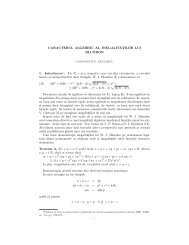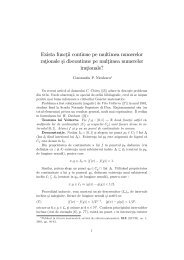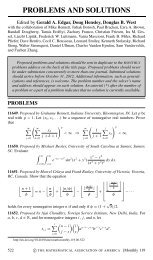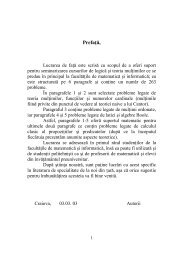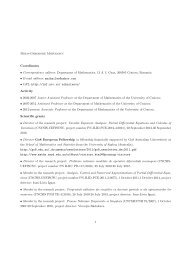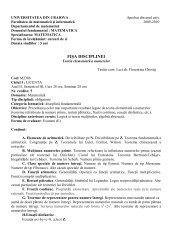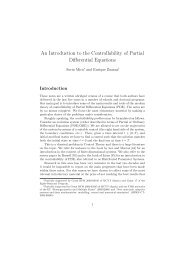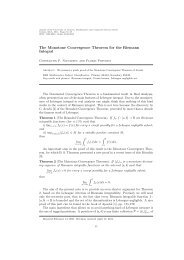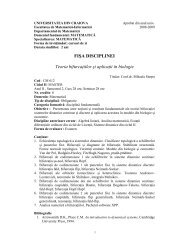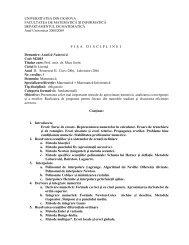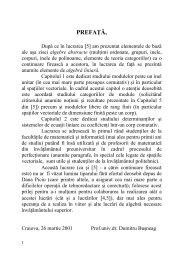CONVEXITY ACCORDING TO THE GEOMETRIC MEAN 1 ...
CONVEXITY ACCORDING TO THE GEOMETRIC MEAN 1 ...
CONVEXITY ACCORDING TO THE GEOMETRIC MEAN 1 ...
Create successful ePaper yourself
Turn your PDF publications into a flip-book with our unique Google optimized e-Paper software.
M athematicalI nequalities& A pplicationsVolume 3, Number 2 (2000), 155–167<strong>CONVEXITY</strong> <strong>ACCORDING</strong> <strong>TO</strong> <strong>THE</strong> <strong>GEOMETRIC</strong> <strong>MEAN</strong>CONSTANTIN P. NICULESCU(communicated by Zs. Páles)Abstract. We develop a parallel theory to the classical theory of convex functions, based on achange of variable formula, by replacing the arithmetic mean by the geometric one. It is shownthat many interesting functions such as exp sinh cosh sec csc arc sin Γ etc illustrate themultiplicative version of convexity when restricted to appropriate subintervals of (0 1) .Asaconsequence, we are not only able to improve on a number of classical elementary inequalitiesbut also to discover new ones.1. IntroductionThe usual definition of a convex function (of one real variable) depends on thestructure of R as an ordered vector space. As R is actually an ordered field, it is naturalto ask what happens when addition is replaced by multiplication and the arithmetic meanis replaced by the geometric mean. A moment’s reflection reveals an entire new worldof beautiful inequalities, involving a broad range of functions from the elementary ones,such as sin, cos, exp, to the special ones, such as Γ Psi L (the Lobacevski’s function),Si ( the integral sine) etc.Depending on which type of mean, arithmetic (A) , or geometric (G) , we considerrespectively on the domain and the codomain of definition, we shall encounter one ofthe following four classes of functions:AA ; convex functions, the usual convex functionsAG ; convex functionsGA ; convex functionsGG ; convex functions.It is worth noticing that while (A) makes no restriction about the interval I whereit applies (it is so because x y 2 I λ 2 [0 1] implies (1 ; λ )x + λ y 2 I) the use of(G) forces us to restrict to the subintervals J of (0 1) in order to assure thatx y 2 J λ 2 [0 1] ) x 1;λ y λ 2 J:Mathematics subject classification (1991): 26A51, 26D05, 26D07, 51M16.Key words and phrases: convex function, AM ; GM Inequality, elementary symmetric functions.Partially supported by MEN Grant no. 39683/1998.c D l, Zagreb155
156 CONSTANTIN P. NICULESCUTo be more specific, the AG; convex functions ( usually known as log ; convexfunctions ) are those functions f : I ! (0 1) for whichx y 2 I and λ 2 [0 1] ) f ((1 ; λ )x + λ y) 6 f (x) 1;λ f (y) λ ( AG )i.e., for which log f is convex.The GG; convex functions (called in what follows multiplicatively convex functions)are those functions f : I ! J (acting on subintervals of (0 1))such thatx y 2 I and λ 2 [0 1] ) f (x 1;λ y λ ) 6 f (x) 1;λ f (y) λ : ( GG )Due to the following form of the AM ; GM Inequality,a b 2 (0 1) λ 2 [0 1] ) a 1;λ b λ 6 (1 ; λ )a + λ b ( )every log ; convex function is also convex.function is Euler’s gamma function,In fact,Z 1Γ(x) =0d1X2log Γ(x) =dx2 The most notable example of such at x;1 e ;t dt x > 0:n = 01(x + n) 2 for x > 0:See [15]. As noticed by H. Bohr and J. Mollerup [2], [1], the gamma function isthe only function f : (0 1) ! (0 1) with the following three properties:(Γ1) f is log ; convex ;(Γ2) f (x + 1) =xf(x) for every x > 0;(Γ3) f (n + 1) =n! for every n 2 N:The class of all GA; convex functions is constituted by all functions f : I ! R(defined on subintervals of (0 1))for whichx y 2 I and λ 2 [0 1] ) f (x 1;λ y λ ) 6 (1 ; λ ) f (x) +λ f (y): ( GA )In the context of twice differentiable functions f : I ! R GA; convexity meansx 2 f 00 + xf 0 > 0 , so that all twice differentiable nondecreasing convex functions are alsoGA; convex. Notice that the inequality () above is of this nature.The aim of this paper is to investigate the class of multiplicatively convex functionsas a source of inequalities. We shall develop a parallel to the classical theory of convexfunctions based on the following remark, which relates the two classes of functions:Suppose that I is a subinterval of (0 1) and f : I ! (0 1) is a multiplicativelyconvex function. ThenF = log f exp : log (I) ! Ris a convex function. Conversely, if J is an interval ( for which exp (J) is a subintervalof (0 1)) and F : J ! R is a convex function, thenf = exp F log : exp (J) ! (0 1)
<strong>CONVEXITY</strong> <strong>ACCORDING</strong> <strong>TO</strong> <strong>THE</strong> <strong>GEOMETRIC</strong> <strong>MEAN</strong> 157is a convex function.Equivalently, f is multiplicatively convex if, and only if, log f (x) is a convexfunction of log x: See Lemma 2.1 below. Modulo this characterization, the class of allmultiplicatively convex functions was first considered by P. Montel [10], in a beautifulpaper discussing the analogues of the notion of convex function in n variables. However,the roots of the research in this area can be traced long before him. Let us mention twosuch results here:HADAMARD’S THREE CIRCLES <strong>THE</strong>OREM. Let f be an analytical function in theannulus a < jzj < b: Then log M(r) is a convex function of log r whereM(r) = sup jf (z)j:jzj = rG. H. HARDY’S <strong>MEAN</strong> VALUE <strong>THE</strong>OREM. Let f be an analytical function in theannulus a < jzj < b and let p 2 [1 1): Then log M p (r) is a convex function of log rwhereZ 1=pM 1 2πp (r) = jf (re iθ )j dθ! p :2π 0As lim n !1 M n (r) =M(r) Hardy’s aforementioned result implies Hadamard’s.As is well known, Hadamard’s result is instrumental in deriving the celebrating Riesz-Thorin Interpolation Theorem (see [5]).Books like those of Hardy, Littlewood and Polya [5] and A. W. Roberts and D. E.Varberg [12] make some peripheric references to the functions f for which log f (x) isa convex function of log x: Nowadays, the subject of multiplicative convexity seemsto be even forgotten, which is a pity because of its richness. What we try to do in thispaper is not only to call the attention to the beautiful zoo of inequalities falling in therealm of multiplicative convexity, but also to prove that many classical inequalities suchas the AM ; GM Inequality can benefit of a better understanding via the multiplicativeapproach of convexity.2. Generalities on multiplicatively convex functionsThe class of multiplicatively convex functions can be easily described as beingconstituted by those functions f (acting on subintervals of (0 1))such that log f (x)is a convex function of log x :LEMMA 2.1. Suppose that I is a subinterval of (0 1) . A function f : I ! (0 1)is multiplicatively convex if, and only if,1 log x 1 log f (x 1 )1 log x 2 log f (x 2 )1 log x 3 log f (x 3 ) > 0for every x 1 6 x 2 6 x 3 in I; equivalently, if and only if,f (x 1 ) log x3 f (x 2 ) log x1 log x2f (x 3 ) > f (x 1 ) log x2 f (x 2 ) log x3 log x1f (x 3 )
158 CONSTANTIN P. NICULESCUfor every x 1 6 x 2 6 x 3 in I:Proof. That follows directly from the definition of multiplicative convexity, takinglogarithms and noticing that any point between x 1 and x 3 is of the form x 1;λ1x3 λ , forsome λ 2 (0 1):COROLLARY 2.2. Every multiplicatively convex function f : I ! (0 1) has finitelateral derivatives at each interior point of I . Moreover, the set of all points where fis not differentiable is at most countable.An example of a multiplicatively convex function which is not differentiable atcountably many points is!1X j log x ; njexp2 n :n = 0By Corollary 2.2, every multiplicatively convex function is continuous in theinterior of its domain of definition. Under the presence of continuity, the multiplicativeconvexity can be restated in terms of geometric mean:<strong>THE</strong>OREM 2.3. Suppose that I is a subinterval of (0 1) . A continuous functionf : I ! [0 1) is multiplicatively convex if, and only if,x y 2 I ) f ( p xy) 6 p f (x)f (y):Proof. The necessity is clear. The sufficiency part follows from the connectionbetween the multiplicative convexity and the usual convexity (as noticed in the Introduction)and the well known fact that mid-convexity (i.e., Jensen convexity) is equivalentto convexity under the presence of continuity. See [5]. Theorem 2.3 above reveals the essence of multiplicative convexity as being theconvexity according to the geometric mean; in fact, under the presence of continuity,the multiplicatively convex functions are precisely those functions f : I ! [0 1) forwhichx 1 ::: x n 2 I ) f ( np x 1 :::x n ) 6 np f (x 1 ):::f (x n ):In this respect, it is natural to call a function f : I ! (0 1) multiplicativelyconcave if 1=f is multiplicatively convex and multiplicatively affine if f is of the formCx α for some C > 0 and some α 2 R:A refinement of the notion of multiplicative convexity is that of strict multiplicativeconvexity, which in the context of continuity will meanf ( np x 1 :::x n ) < np f (x 1 ):::f (x n )unless x 1 = ::: = x n : Clearly, our remark concerning the connection between the multiplicativelyconvex functions and the usual convex functions has a ”strict” counterpart.A large class of strictly multiplicatively convex functions, is indicated by thefollowing result, which developed from [5], Theorem 177, page 125:PROPOSITION 2.4. Every polynomial P(x) with non-negative coefficients is a multiplicativelyconvex function on [0 1): More generally, every real analytic function
<strong>CONVEXITY</strong> <strong>ACCORDING</strong> <strong>TO</strong> <strong>THE</strong> <strong>GEOMETRIC</strong> <strong>MEAN</strong> 159P 1f (x) = n = 0 c nx n with non-negative coefficients is a multiplicatively convex functionon (0 R) where R denotes the radius of convergence :Moreover, except for the case of functions Cx n ( with C > 0 and n 2 N) theabove examples are strictly multiplicatively convex functions.Examples of such real analytic functions are:exp sinh cosh on (0 1)1tan sec cscx ; cot xarc sin on (0 1]1 + x; log(1 ; x)1 ; xon (0 π=2)on (0 1):See the table of series of I. S. Gradshteyn and I. M. Ryzhik [4].Proof. P By continuity, it suffices to prove only the first assertion. For, suppose thatNP(x) = n = 0 c nx n : According to Theorem 2.3, we have to prove thatx y > 0 ) (P( p xy)) 2 6 P(x)P(y)equivalently,x y > 0 ) (P(xy)) 2 6 P(x 2 )P(y 2 ):Or, the latter is an easy consequence of the Cauchy-Schwarz Inequality.REMARK 2.1. i) If a function f is multiplicatively convex, then so is x α f β (x)(forall α 2 R and all β > 0):ii) If f is continuous, and one of the functions f (x) x and f (e 1=log x ) is multiplicativelyconvex, then so is the other.REMARK 2.2. S. Saks [13] noticed that for a continuous function f : I ! (0 1)log f (x) is a convex function of log x if, and only if, for every α > 0 and everycompact subinterval J of I , x α f (x) should attain its maximum in J at one of the endsof J .APPLICATIONS. Proposition 2.4 is the source of many interesting inequalities. Hereare several elementary examples, obtained via Theorem 2.3:a) (See D. Mihet [9]). If P is a polynomial with non-negative coefficients thenP(x 1 ):::P(x n ) > (P( np x 1 :::x n )) n for every x 1 ::: x n > 0:This inequality extends the classical inequality of Huygens (which corresponds tothe case where P(x) =1 + x ) and complements a remark made by C. H. Kimberling[7] to Chebyshev’s Inequality, namely,if all x k are either in [0 1] or in [1 1):(P(1)) n;1 P(x 1 :::x n ) > P(x 1 ):::P(x n )
160 CONSTANTIN P. NICULESCUA similar conclusion is valid for every real analytic function as in Proposition 2.4above.b) The AM ; GM Inequality is an easy consequence of the strict multiplicativeconvexity of e x on [0 1): A strengthened version of this will be presented in Section5 below.c) Because 1 + x is strictly multiplicatively convex on (0 1)1 ; xnYk= 11 + x k1 ; x k> 1 +(Qxk ) 1=n1 ; ( Q x k ) 1=n nfor every x 1 ::: x n 2 [0 1)unless x 1 = ::: = x n :d) Because arc sin is a strictly multiplicatively convex function on (0 1] in anytriangle (excepts for the equilateral ones) the following inequality sin A 2 sin B 2 sin C 1 33p2 < sin( ABC )2holds. That improves on a well known fact namely,sin A 2 sin B 2 sin C 1 2 < 8unless A = B = C (which is a consequence of the strict log ; concavity of the functionsin): In a similar way one can argue thatcos A 2 cos B 2 cos C 1 32 < sin(3p(π ; A)(π ; B)(π ; C))2unless A = B = C:e) As tan is a strictly multiplicatively convex function on (0 π=2) in any trianglewe have tan A 2 tan B 2 tan C 1 33p2 > tan( ABC)2unless A = B = C:The next example provides an application of Proposition 2.4 via Lemma 2.1:f ) If 0 < a < b < c (or 0 < b < c < a or 0 < c < a < b) thenP(a) log c P(b) log a P(c) log b > P(a) log b P(b) log c P(c) log afor every polynomial P with non-negative coefficients and positive degree (and, moregenerally, for every strictly multiplicatively convex function). That complements theconclusion of the standard rearrangement inequalities (cf. [3], page 167): If 0 < a 0 thenP(a) log c P(b) log b P(c) log a = infσP(a) log a P(b) log b P(c) log c = supσP(a)log σ(a) P(b) log σ(b) log σ(c)P(c)P(a) log σ(a) P(b) log σ(b) log σ(c)P(c)where σ runs the set of all permutations of fa b cg :The integral characterization of multiplicatively convex functions is another sourceof inequalities. We leave the (straightforward) details to the interested reader.
<strong>CONVEXITY</strong> <strong>ACCORDING</strong> <strong>TO</strong> <strong>THE</strong> <strong>GEOMETRIC</strong> <strong>MEAN</strong> 1613. The analogue of Popoviciu’s InequalityThe technique of majorization, which dominates the classical study of convexfunctions, can be easily adapted in the context of multiplicatively convex functionsvia the correspondence between the two classes of functions (as mentioned in theIntroduction). We shall restrict here to the multiplicative analogue of a famous inequalitydue to Hardy, Littlewood and Polya [5]:PROPOSITION 3.1. Suppose that x 1 > x 2 > ::: > x n and y 1 > y 2 > ::: > y n aretwo families of numbers in a subinterval I of (0 1) such thatThenx 1 > y 1x 1 x 2 > y 1 y 2:::x 1 x 2 :::x n;1 > y 1 y 2 :::y n;1x 1 x 2 :::x n = y 1 y 2 :::y n :f (x 1 )f (x 2 ):::f (x n ) > f (y 1 )f (y 2 ):::f (y n )for every multiplicatively convex function f : I ! (0 1):A result due to H. Weyl [14] (see also [8], p. 231) gives us the basic exampleof a pair of sequences satisfying the hypothesis of Proposition 3.1: Given any matrixA 2 M n (C ) having the eigenvalues λ 1 ::: λ n and the singular values s 1 ::: s n theycan be rearranged such thatjλ 1 j > ::: > jλ n j mY Yλ k 6mk = 1k = 1s 1 > ::: > s ns k for k = 1 ::: n ; 1 and nY λ k =Recall that the singular values of A are precisely the eigenvalues of its modulus,jAj =(A ? A) 1=2 : The spectral mapping theorem assures that s k = jλ k j when A is selfadjoint.One could suppose that for an arbitrary matrix, jλ k j 6 s k for all k: However,this is not true. A counter example is given by the matrix 0 14 0whose eigenvalues are λ 1 = 2 > λ 2 = ;2 and the singular values are s 1 = 4 > s 2 = 1:As noticed A. Horn [6](see also [8], p. 233), the converse of Weyl’s aforementionedresult is also true, i.e., all the families of numbers which fulfil the hypotheses ofProposition 3.1 come that way.According to the above discussion, the following result holds:PROPOSITION 3.2. Let A 2 M n (C ) be any matrix having the eigenvalues λ 1 ::: λ nand the singular values s 1 ::: s n listed such that jλ 1 j > ::: > jλ n j and s 1 > ::: > s n .ThennY Yf (s k ) > n f (jλ k j)k = 1k = 1k = 1nYk = 1s k :
162 CONSTANTIN P. NICULESCUfor every multiplicatively convex function f which is continuous on [0 1):We shall give another application of Proposition 3.1, which seems to be new evenfor polynomials with non-negative coefficients:<strong>THE</strong>OREM 3.3. (The multiplicative analogue of Popoviciu’s Inequality [11]) : Supposethat f : I ! (0 1) is a multiplicatively convex function. Thenf (x) f (y) f (z) f 3 ( 3p xyz) > f 2 ( p xy) f 2 ( p yz) f 2 ;p zx for every x y z 2 I: Moreover, for the strictly multiplicatively convex functions theequality occurs only when x = y = z:Proof. Without loss of generality we may assume that x > y > z: Thenp xy >p zx >p yz and x >3 p xyz > z:If x > 3p xyz > y > z the desired conclusion follows from Proposition 3.1applied tox 1 = x x 2 = x 3 = x 4 = 3p xyz x 5 = y x 6 = zy 1 = y p 2 = xy y 3 = y p 4 = xz y 5 = y p 6 = yzwhile in the case x > y > 3p xyz > z we have to considerx 1 = x x 2 = y x 3 = x 4 = x 5 = 3p xyz x 6 = zy 1 = y 2 = p xy y 3 = y 4 = p xz y 5 = y 6 = p yz : According to Theorem 3.3 (applied to f (x) =e x ) , for every x y z > 0wehavex + y + z3+ 3p xyz > 2 3; pxy+p yz +p zxunless x = y = z:Other homogeneous inequalities can be obtained by extending Proposition 3.3 tolonger sequences and/or to more general convex combinations.4. Multiplicative convexity of special functionsWe start this section by recalling the following result:PROPOSITION 4.1. (P. Montel [10]) Let f : [0 a) ! [0 1) be a continuousfunction, which is multiplicatively convex on (0 a) . ThenZ xF(x) =0f (t) dtis also continuous on [0 a) and multiplicatively convex on (0 a) .
<strong>CONVEXITY</strong> <strong>ACCORDING</strong> <strong>TO</strong> <strong>THE</strong> <strong>GEOMETRIC</strong> <strong>MEAN</strong> 163Proof. Montel’s original argument was based on the fact that under the presenceof continuity, f is multiplicatively convex if, and only if,2f (x) 6 k α f (kx) +k ;α f (x=k)for every x 2 I and every k > 0 such that kx and x=k both belong to I:Actually, due to the continuity of F it suffices to show that(F( p xy)) 2 6 F(x) F(y) for every x y 2 [0 a)which is a consequence of the corresponding inequality at the level of integral sums," pxy Xn;1 p xy# 2 "x Xn;1f k 6 f k x #" y Xn;1f k y #nn n n n ni.e., ofk = 0" n;1Xk = 0fkp xyn# 2 "X n;16k = 0k = 0To see that the latter inequality holds, notice that p xy 2 h f k 6 f k x nnand then apply the Cauchy-Schwarz Inequality.fk = 0k x #" Xn;1f k y nn # :k = 0ihfk y inAs tan is continuous on [0 π=2) and multiplicatively convex on (0 π=2) arepeated application of Proposition 4.1 shows us that the Lobacevski’s function,Z xL(x) =;0log cos tdtis multiplicatively convex on (0 π=2) .tStarting withsin tand then switching to sin tt which is multiplicatively concave,a similar argument leads us to the fact that the integral sine,Z xsin tSi(x) = dt tis multiplicatively concave on (0 π=2):Another striking example is the following:0PROPOSITION 4.2. Γ is a strictly multiplicatively convex function on [1 1):Proof. In fact, log Γ(1 + x) is strictly convex and increasing on (1 1) .Or,anincreasing strictly convex function of a strictly convex function is strictly convex too.So, F(x) =log Γ(1 + e x ) is strictly convex on (0 1) and thusF(log x)Γ(1 + x) =e
164 CONSTANTIN P. NICULESCUis strictly multiplicatively convex on [1 1): As Γ(1 + x) =xΓ(x) we conclude thatΓ itself is strictly multiplicatively convex on [1 1): According to Proposition 4.2,Γ 3 ( 3p xyz) < Γ(x) Γ(y) Γ(z) for every x y z > 1except the case where x = y = z:On the other hand, by Theorem 3.3, we infer thatΓ(x) Γ(y) Γ(z) Γ 3 ( 3p xyz) > Γ 2 ( p xy) Γ 2 ( p yz) Γ 2 ;p zx for every x y z > 1; the equality occurs only for x = y = z:Probably, the last two inequalities work in the reversed form when x y z 2 (0 1]but at the moment we are unable to prove that.Another application of Proposition 4.2 is the fact that the function Γ(2x+1) is strictlyΓ(x+1)multiplicatively convex on [1 1) . In fact, it suffices to recall the Gauss-Legendreduplication formula,Γ(2x + 1)Γ(x + 1) = 22x Γ(x + 1=2)p : πIn order to present further inequalities involving the gamma function we shall needthe following criteria of multiplicative convexity for differentiable functions:PROPOSITION 4.3. Let f : I ! (0 1) be a differentiable function defined on asubinterval of (0 1) : Then the following assertions are equivalent:i) f is multiplicatively convex ;ii) The function xf0 (x)fis nondecreasing ;(x)iii) f verifies the inequalityf (x)f (y) > xy yf 0 (y) = f (y)for every x y 2 I:If moreover f is twice differentiable, then f is multiplicatively convex if, and onlyif,x[ f (x)f 00 (x) ; f 0 2 (x)] + f (x)f 0 (x) > 0 for every x > 0:The corresponding variants for the strictly multiplicatively convex functions alsowork.Proof. In fact, according to a remark in the Introduction, a function f : I ! (0 1)is multiplicatively convex if, and only if, the function F : log(I) ! R , F(x) =log f (e x ) is convex. Taking into account that the differentiability is preserved under theabove correspondence, the statement to be proved is just a translation of the usual criteriaof convexity (as known in the differentiability framework) into criteria of multiplicativeconvexity. Directly related to the gamma function is the psi function,Psi (x) =d dx log Γ(x) = Γ0 (x)Γ(x) x > 0
<strong>CONVEXITY</strong> <strong>ACCORDING</strong> <strong>TO</strong> <strong>THE</strong> <strong>GEOMETRIC</strong> <strong>MEAN</strong> 165also known as the digamma function. It satisfies the functional equation ψ (x + 1) =and can be also be represented asψ (x) + 1 xPsi (x) =;γ ;Z 10t x;1 ; 11 ; twhere γ = : 57722 is Euler’s constant. See [4].By combining Propositions 4.2 and 4.3 above, we obtain the inequalityΓ(x)Γ(y) > xydt yPsi(y)for every x y > 1 (Psi)as well as the fact that xPsi (x) is increasing for x > 1:The latter inequality can be used to estimate Γ from below on [1 2] . The interestcomes from the fact that Γ is convex and attains its global minimum in that intervalbecause Γ(1) = Γ(2); more precisely, the minimum is attained near 1.46. Takingy = 1 and then y = 3=2 in(Psi), we getΓ(x) > max(x ;γ 1 2p π 2x3 3=2 (2;γ ;2ln2))for every x 2 [1 2]:5. An estimate of the AM-GM InequalitySuppose that I is a subinterval of (0 1) and that f : I ! (0 1) is a twicedifferentiable function. We are interested to determine for what values α 2 R thefunction(;α=2) log xϕ(x) =f (x) xis multiplicatively convex on I , equivalently, for what values α 2 R the functionis convex on log(I) .Φ(x) =log ϕ(e x )=log f (e x ) ; α x22 By using the fact that the convexity of a twice differentiablefunction Φ is equivalent to Φ 00 > 0 we get a quick answer to the aforementionedproblem:α 6 A(f )whereA(f ) = infx 2 log(I)By considering alsod 2dx 2 log f (ex )=x 2 (f (x)f 00 (x) ; (f 0 (x)) 2 )+xf(x) f 0 (x)= infx 2 log(I)f (x) 2 :B(f )=supx 2 log(I)d 2dx 2 log f (ex )
166 CONSTANTIN P. NICULESCUwe arrive at the following result: Under the above hypotheses, A(f ) XnY 1=n0 !Yexp2n 2 (log x j ; log x k ) 2 6 f (x k )!= f @n 1=n1x kAj
<strong>CONVEXITY</strong> <strong>ACCORDING</strong> <strong>TO</strong> <strong>THE</strong> <strong>GEOMETRIC</strong> <strong>MEAN</strong> 167[6] A. HORN, On the eigenvalues of a matrix with prescribed singular values, Proc. Amer. Math. Soc. 5(1954), 4–7.[7] C. H. KIMBERLING, Some Corollaries to an Integral Inequality, Amer. Math. Month., 81 (1974),269–270.[8] A. W. MARSHALL AND I. OLKIN, Inequalities: Theory of Majorization and its Applications, AcademicPress, 1979.[9] D. MIHET, An extension of the Inequality of Huygens, Revista Matematica din Timisoara, 1 (1990), no.2, pp. 6–7. (Romanian)[10] P. MONTEL, Sur les functions convexes et les fonctions sousharmoniques, Journal de Math. (9), 7 (1928),29–60.[11] T. POPOVICIU, Sur certaines inégalités qui caractérisent les fonctions convexes, Analele Stiintifice Univ.”Al. I. Cuza”, Iasi, Sectia Mat., 11 (1965), 155–164.[12] A. WAYNE ROBERTS AND DALE E. VARBERG, Convex Functions, Academic Press, New York andLondon, 1973.[13] SAKS S., Sur un theoreme de M. Montel, C. R. Acad. Paris, 187 (1928), 276–277.[14] H. WEYL, Inequalities between two kinds of eigenvalues of a linear transformation, Proc. Nat. Acad.Sci. U.S.A., 35 (1949), 408–411.[15] E. T. WHITTAKER AND G. N. WATSON, A course on Modern Analysis, 4th. ed., Cambridge, 1927.(Received June 22, 1999)Constantin P. NiculescuUniversity of CraiovaDepartment of MathematicsStreet A. I. Cuza 13Craiova 1100Romania e-mail: tempus@oltenia.ro



